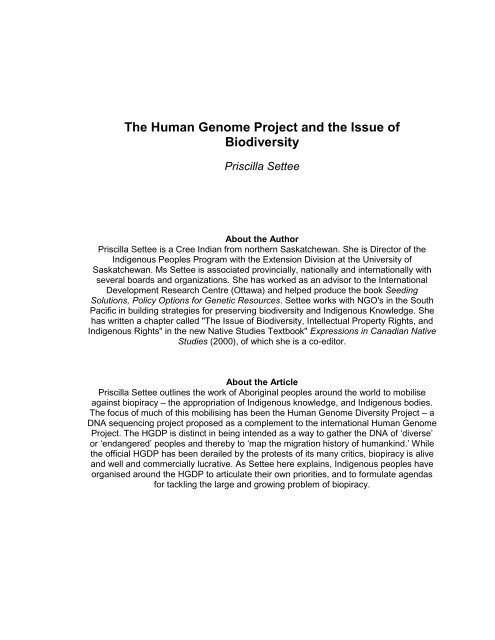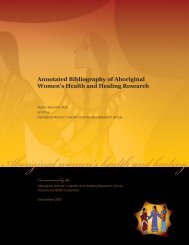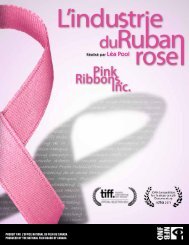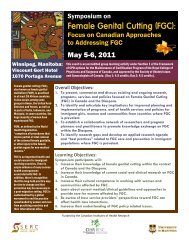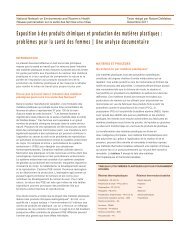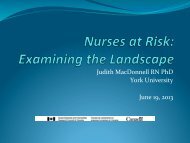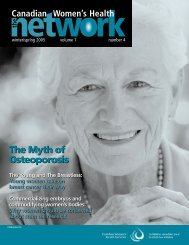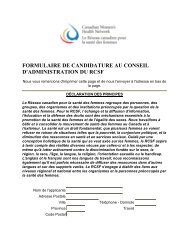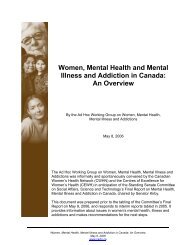from Priscilla Settee - Canadian Women's Health Network
from Priscilla Settee - Canadian Women's Health Network
from Priscilla Settee - Canadian Women's Health Network
- No tags were found...
Create successful ePaper yourself
Turn your PDF publications into a flip-book with our unique Google optimized e-Paper software.
The Human Genome Project and the Issue ofBiodiversity<strong>Priscilla</strong> <strong>Settee</strong>About the Author<strong>Priscilla</strong> <strong>Settee</strong> is a Cree Indian <strong>from</strong> northern Saskatchewan. She is Director of theIndigenous Peoples Program with the Extension Division at the University ofSaskatchewan. Ms <strong>Settee</strong> is associated provincially, nationally and internationally withseveral boards and organizations. She has worked as an advisor to the InternationalDevelopment Research Centre (Ottawa) and helped produce the book SeedingSolutions, Policy Options for Genetic Resources. <strong>Settee</strong> works with NGO's in the SouthPacific in building strategies for preserving biodiversity and Indigenous Knowledge. Shehas written a chapter called "The Issue of Biodiversity, Intellectual Property Rights, andIndigenous Rights" in the new Native Studies Textbook" Expressions in <strong>Canadian</strong> NativeStudies (2000), of which she is a co-editor.About the Article<strong>Priscilla</strong> <strong>Settee</strong> outlines the work of Aboriginal peoples around the world to mobiliseagainst biopiracy – the appropriation of Indigenous knowledge, and Indigenous bodies.The focus of much of this mobilising has been the Human Genome Diversity Project – aDNA sequencing project proposed as a complement to the international Human GenomeProject. The HGDP is distinct in being intended as a way to gather the DNA of ‘diverse’or ‘endangered’ peoples and thereby to ‘map the migration history of humankind.’ Whilethe official HGDP has been derailed by the protests of its many critics, biopiracy is aliveand well and commercially lucrative. As <strong>Settee</strong> here explains, Indigenous peoples haveorganised around the HGDP to articulate their own priorities, and to formulate agendasfor tackling the large and growing problem of biopiracy.
The Human DNA of identified Indigenousgroups is the focus of curiosity and activityamong an international consortium ofscientists, universities, governments, andother interests in North America andEurope. 1Over 700 Indigenous groups world-widehave been identified to have samplescollected <strong>from</strong> them. Indigenouscommunities targeted for DNA collectioninclude Africa (165), Asia (212), SouthAmerica (114), Oceania (101) NorthAmerica (107 tribes) and Europe (23).Established in 1992, the Human GenomeDiversity Project (HGDP) will take blood,tissue samples (cheek scrapings orsaliva), and hair roots <strong>from</strong> hundreds ofIndigenous communities throughout theworld. Through the Human GenomeOrganization (HUGO) the project ismandated to map the entire geneticstructure of the human raceHUGO seeks to sequence the DNAinformation in all 100,000 genes in thehuman body and is expected to cost 3billion dollars over the span of the fifteenyear project; HUGO is now nearingcompletion significantly ahead ofschedule; a ‘rough draft’ has already beencompleted. While HUGO intends touncover the norm of the human genomeas a composite model, the HumanGenome Diversity Project seeks to mapand sequence genetic diversity. Theproject is specifically mandated to takeblood, tissue, and hair samples <strong>from</strong>1 This article draws on the following sourcematerial: Indigenous Women Address theWorld. Indigenous Woman Magazine. SpecialBeijing Edition, Rapid City, South Dakota,U.S.A. 1996; Indigenous Woman Magazine,Rapid City, South Dakota, U.S.A., Vol, 2, No.3, 1996; Dukepoo, F., & Harry, D. IndigenousPeoples Coalition on Biopiracy, 1998; “Voice ofNative Grassroots for Environmental Justice.”Indigenous Environmental <strong>Network</strong> News.Vol.3 No. 2, 1997; Western Shoshone DefenseProject Newsletter, 1997."endangered" indigenous communitiesaround the world.The HGD project was formally adopted in1994 by the Human GenomeOrganization. It has sought massivefunding. This multi-billion dollar initiative byscientists has plans to sequence the DNAin the entire human genetic structure. TheHGDP seeks to map the genetic differenceof groups <strong>from</strong> the monotype genome thatwill be identified by the HUGO effort.Scientists believe that many of the world'sIndigenous people are in danger ofbecoming extinct and refer to them as‘isolates of historic interest’. Scientistshope to gather DNA samples <strong>from</strong> theliving before they disappear forever, andso avoid the irreversible loss of preciousgenetic information. Indigenous peoplesfind it reprehensible that scientists' interestis purely to document scientific geneticinformation rather than to preserve tribalgroups. In effect, the scientists are askingendangered tribal groups to submitpersonal samples before their groupdisappears. The scientists' actions reviveout-dated and oppressive attitudes, andtheir actions instil self-fulfilling pessimism.Such actions are simply unethical.Blood samples taken <strong>from</strong> Indigenouspeoples will become immortalized forfuture study. A technique called "cellconservation" will keep certain cells of anorganism alive and capable of multiplying.Unlimited amounts of the organism's DNAwill be stored at various gene banks,mostly in the United States.Indigenous peoples have many concernswith the HGDP. One is the issue ofinformed consent. Although the HDGPclaims that it will seek the consent of theindividuals and populations concerned,many people doubt whether this will, infact, happen. Some questions that remainunanswered are:2
• Can tribal leaders give consent for thewhole tribe?• Can one person give consent whileothers don't?• How can some of these concepts beexplained in ways and languages forpeople who have no concept or words forthese confusing terms?• What are the benefits for the localcommunities?• Will decisions to refuse consent be fullyrespected?The HGDP North American Committeesecured a grant to develop a modelprotocol or rules for the collection ofsamples <strong>from</strong> Indigenous groups. It is feltby Indigenous people that this protocol willprimarily be used to seek project cooperation.The HGDP states that the research willhelp reconstruct the history of the world'spopulations, address questions about thehistory of human evolution and migrationpatterns, and identify the origins of existingpopulations. While the HGDP is looking foranswers about human evolution,Indigenous peoples already possessstrong beliefs and knowledge regardingtheir creation and histories.Danny Billie, traditional spokesman for theIndependent Seminole Nation of Florida,stated in 1997“The white people are trying to playGod. If they continue to do what theyare doing the impact to the humanspecies, insects, plant and animal life isgoing to be devastating. They think thatthey can get away with it, but they'llalso suffer the consequences.”In response to the HGDP researchIndigenous peoples <strong>from</strong> various parts ofthe world have mobilized against theproject. Documents such as the UkupseniDeclaration <strong>from</strong> Panama and the NationalCongress of American Indians ResolutionNo. 93-118 have been signed. Thesedocuments represent hundreds ofcommunities who declare their oppositionto the HGDP.Karioca Declaration. In the early 1980's,the Karioca Declaration was signed by agroup of Indigenous people who wereopposed to the HGDP and who met priorto the 1993 United Nations Conference atthe Earth Summit in Rio de Janeiro.Mataatua Declaration. The KariocaDeclaration was followed ten years laterby the Mataatua Declaration and signedby over 150 participants <strong>from</strong> 14 UnitedNations countries. The Declaration callsfor an immediate halt to the ongoingHGDP until all aspects of it could beunderstood by Indigenous peoples.Article 29. In 1994 The United Nations'working group on Indigenous populations,along with the Sub-Commission on thePrevention of Discrimination andProtection of Minorities approved Article29 of the Declaration of the Rights ofIndigenous Peoples which stated:“Indigenous Peoples are entitled to therecognition of the full ownership, controland protection of their cultural andintellectual property. They have therights to special measures to control,develop and protect their sciences,technologies and culturalmanifestations including human andother genetic resources, seeds,medicines, knowledge of the propertiesof fauna and flora, oral traditions,literatures, designs, and visual andperforming arts.”New Zealand. In 1993 an assembly ofrepresentatives of the tribes <strong>from</strong> theNorth and South Islands of Aotearoa (NewZealand) passed resolutions condemningthe HGDP and the patenting of life-forms.National Congress of American Indians. Inthat same year the National Congress of3
American Indians (the oldest and largestnational organization, comprised ofrepresentatives <strong>from</strong> 67l American Indiantribal governments in the United States)passed a resolution condemning theHGDP and called upon all related activitiesto cease immediately.Central Australian Aboriginal Congress.Coined as the "Vampire Project" by theWorld Congress of Indigenous Peoples,the Central Australian Aboriginal CongressPosition Paper stated in 1993:“The Vampire Project is legalized theft.The Vampire scientists are planning totake and to own what belongs toIndigenous People. We must makesure that our people are not exploitedonce more by corporations,governments, and their scientists.”Maori Congress. In 1994 at the MaoriCongress Indigenous PeoplesRoundtable, Indigenous participants <strong>from</strong>the World Council of Indigenous Peoples,Greenland Home Rule Government,COICA (Peru), Treaty Six Chiefs ofAlberta, and governmental representatives<strong>from</strong> Vanuatu, Papua New Guinea, andFiji declared that:“The collection of genetic samples <strong>from</strong>Indigenous peoples such as the HumanGenome Diversity Project, is unethicaland immoral and must be brought to animmediate halt.”Patents on Indigenous Peoples. Also in1994 in Panama, the Guaymi Indians,along with citizens of Papua New Guineaand the Solomon Islands, discovered thatthe United States government had takenpatent claims out on the cell lines <strong>from</strong>some of their people. Through effectivecampaigning they were able to have thepatent claim abandoned.Workshop on “Intellectual PropertyRights”. In August 1994, the InternationalAcademy of the Environment, along withthe World Wildlife Federation and theUnited Nations Centre for Human Rights,organized an information workshop on"Intellectual Property Rights andIndigenous Peoples" stating:“The issue of HUGO, and othersrelated to human genes, is a seriousviolation of our peoples' rights. Withoutconsultation with the indigenouscommunities, several projects are nowtaking blood, hair, tissue and othersamples for purposes that are not clear.This practice of collecting sampleswithout our approval is very dangerousbecause in this way our geneticmaterial can be patented or used forother purposes. Such practices not onlyviolate ethics and human rights, butalso violate nature, our spirituality, andour knowledge of creation thatconnects us with all forms of life.”Latin and South American Consultation. InBolivia in September 1994, the Latin andSouth American Consultation onIndigenous Peoples Knowledge rejectedthe HGDP and human genetic research.Asian Consultation. Similarly in Malaysiain 1995, the Asian consultation on theProtection and Conservation of IndigenousPeoples Knowledge rejected the HGDP.Declaration of IndigenousOrganizations. In Arizona, at the sametime, Indigenous leaders <strong>from</strong> US,Canada, Panama, Ecuador, Peru,Bolivia, and Argentina, formulated aDeclaration of IndigenousOrganizations of the WesternHemisphere. It considered theresponsibility to future generations:“We have a responsibility to speak forall life forms and to defend the integrityof the natural order. We particularlyoppose the HGDP which intends tocollect, and make available our geneticmaterials which may be used forcommercial, scientific and military4
purposes. We oppose the patenting ofall natural genetic materials. We holdthat life cannot be bought, owned, sold,discovered or patented, even in itssmallest forms.”PAHO. In April 1995 the Pan-American<strong>Health</strong> organization passed a resolutionopposing the HGDP, and stated:“This type of research will have anegative impact on future healthprogrammes and projects in indigenouscommunities, by underminingindigenous peoples' trust in the medicaland health professions.”The Pacific Consultation. The PacificConsultation on the Protection andConservation of Indigenous PeoplesKnowledge developed a Treaty declaring aLife-Forms Patent Free Pacific, withspecific objections directed to the HGDP.North American Indigenous Peoples’Summit. In August of 1997, severalhundred Indigenous peoples representingmany tribes and over 60 organizations metto discuss the impact of the newbiotechnology on their homelands andtheir people. This meeting was called "theNorth American Indigenous Peoples’Summit on Biological Diversity andBiological Ethics" It established the “Heartof the People Declaration”. The preamble"expresses our profound concern for thewell being of our Mother Earth and theIndigenous circle of Life known as'biological diversity'." The Declarationfurther states:“We wish to add our voices to ongoingglobal discussions regarding theprotection of biological diversity, thesafeguarding of traditional knowledgeand sustainable development practices,and the ethical use and treatment of allforms of life in harmony, respect andthe spiritual interconnectedness of thenatural world.”Ukupseni Declaration. In November of1997, Indigenous people representing 25organizations <strong>from</strong> 15 countries met inPanama to discuss the HGDP and theissue of human genetic piracy. Thismeeting was one the first opportunities forIndigenous people <strong>from</strong> Latin America tomeet with North American Indigenouspeople who were working on the HGDPissue. The Ukupseni Declaration on theHuman Genome Diversity Project wasestablished as a result of the two-daymeeting. The Declaration condemns theHGDP:“It calls for a moratorium on thecollection of genetic samples <strong>from</strong>indigenous peoples, and demands therepatriation of genetic samples anddata already obtained by unethicalmeasures. It opposes the application ofintellectual property law, and patents, tohuman genes. It calls upon scientists todenounce any research conducted in amanner that violates the protocols thatprotect the human rights of humansubjects. Finally it calls upon allies towork with Indigenous Peoples todemand protection for the human andcollective rights of Indigenous Peoples.”The Indigenous Peoples Coalition onBiopiracy. The Indigenous PeoplesCoalition on Biopiracy was established in1998 to address the theft of Indigenousblood, hair, and skin sampling, and as aconcerted response to the HGDP.Coalition participants worked on strategiesto protect their communities <strong>from</strong>exploitation. Members disseminatedinformation to the local grass-roots levels.They built alliances for sharing currentinformation as well as for implementingcollaborative action and support amongthe participating organizations andindividuals. An extensive list of key pointshas been developed by this coalition, thedirect quotation <strong>from</strong> the document is asfollows:“After careful review of HGDP and5
other independent investigations on thegenome of indigenous peoples:a. We declare absolute opposition tothe Human Genome Diversity Project,and demand the immediate suspensionof any activities to collect geneticsamples, cell lines, or genetic data <strong>from</strong>indigenous peoples, including ourdeceased ancestors.b. We demand the fullest cooperationof any government agency orindependent research institute in thereturn of all genetic materials, cell lines,and data they may have in theirpossession to the appropriategoverning authorities of the tribal group.c. We oppose any attempt tomonopolize or commercialize thegenetic samples, cell lines, or dataderived <strong>from</strong> the cell lines of Indigenouspeoples through the application ofintellectual property law and patentsystems.d. We oppose the genetic engineeringof Indigenous peoples’ genes andcloning. This includes cloningIndigenous peoples’ genes or genefragments into bacterial, viral,mammalian cell lines, or other vectors.We demand the immediate suspensionof activities that are currently using anyIndigenous peoples' DNA, genes orfragments in any cloningexperimentation.e. We demand the internationalscientific community condemn anyresearch that has been carried outcontrary to recognized human valuesand moral principles, and that violatesthe international codes of ethicsdescribed in the Nuremberg code andthe World Medical AssociationDeclaration of Helsinki.f. We reaffirm the governing entities ofIndigenous tribal peoples/nations havethe primary authority to deny access to,refuse to participate in, or to authorizeany removal of genetic materials <strong>from</strong>our peoples or territories. The ethicalprinciple of "individual informedconsent" is also applicable, and issecondary to tribal governmentalconsent.g. We demand that scientific endeavorsand resources be prioritized to supportand improve social, economic andenvironmental conditions of Indigenouspeoples in their environments, therebydirectly improving health conditions andraising the overall quality of life.h. We demand an immediatemoratorium on collections and/orpatenting of genetic materials <strong>from</strong>Indigenous persons and communitiesby any scientific project, healthorganization, governments,independent agencies, or individualresearchers.i. We demand that the US governmentand any governing agencies, to notparticipate, fund or provide anyassistance to the HGDP, or any relatedresearch projects which seek toresearch the genome of indigenouspeoples.j. We denounce the integrity of thereport by the Committee on HumanGenome Diversity of the NationalResearch council which gives unethicalendorsement to the Human GenomeDiversity Project while acknowledgingthe "lack of a sharply defined proposalthat it could evaluate".”As Indigenous peoples we have manyunanswered questions regarding the newbiotechnology industry, many of themcentre around the issue of respect andsome refer to the expropriation of thecircle of life or biodiversity. In many of ourcommunities these activities have beenreferred to as the final act of colonialismagainst Indigenous peoples. I havereported the concerns that IndigenousPeoples have not only about the HGDPbut about the potential threat tosovereignty and well being that theft ofbiodiversity has on Indigenouscommunities in North America andglobally.6


